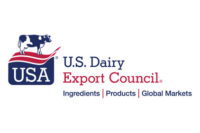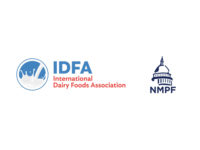U.S. Dairy Exports Grew in 2010
As the lines between domestic and overseas markets continue to blur, U.S. dairy suppliers registered record export volumes in 2010.
On a total solids basis, U.S. dairy exports reached 3.04 billion pounds last year, up 40% from 2009 and up 19% from 2008. Overseas shipments were valued at $3.71 billion, 63% higher than 2009, according to government trade data.
Nearly all product categories posted big increases in 2010: milk powder shipments expanded by more than 60%, butterfat volumes doubled and exports of cheese, whey products and lactose reached record levels.
With these gains, a growing and significant proportion of the U.S. milk supply is being sold overseas, notes the U.S. Dairy Export Council (USDEC), Arlington, Va. Exports were equivalent to 12.8% of U.S. milk production, up from 9.3% in 2009 and 11% in 2008. The ratio of milk powder, dry whey and cheese sold offshore was the highest ever, a sign of how important exports have become to health of the U.S. dairy industry.
“U.S. dairy suppliers resumed their growth path in 2010 after a sharp drop in 2009, yet this welcome result shouldn’t obscure the fact that this is part of an expected, long-term growth trend,” says USDEC president Tom Suber.
“Increased trade is driven by a variety of demand factors,” he explains. “Dairy has become an integral part of the diet in large emerging markets like China, India and Southeast Asia as purchasing power there has advanced to the point that they are able to pay more for products they now desire. There are 43 million babies born every year in China and India, and more than ever those infants will start drinking milk-based formula early on. Fast food chains are expanding dramatically in developing markets, bringing pizza, cheeseburgers and other western foods to millions each day. As a result, cheese exports rose 60%, pushing the United States past Australia as the world’s third-largest supplier, behind the EU-27 and New Zealand. At the same time, local milk producers and traditional international suppliers cannot keep pace with the needs of the world’s expanding middle class. This creates significant opportunity for the U.S. dairy industry,” he says.
China’s ‘voracious’ appetite
Of the growing dairy markets in 2010, none had a larger impact on global demand than China. The nation imported 326,000 metric tons of whole milk powder, seven times its 2008 total, and 89,000 metric tons of skim milk powder, a 64% gain over two years. Its share of international whole milk powder trade has grown to around 15%, compared with just 3% in 2008, USDEC notes. The impact of China’s voracious appetite for dairy proteins is twofold: It creates direct opportunities for U.S. suppliers of milk powder, whey, lactose and cheese in China, and provides indirect opportunities, absorbing huge quantities of whole milk powder from Oceania, which creates geographic and product holes for U.S. exports to fill.
Suppliers must move to the next level of sophistication
U.S. suppliers have grown more comfortable with doing business overseas, Suber says. Many companies have committed the necessary resources to grow their export business and adopted an attitude to service foreign buyers. Long-term trade data paint an optimistic future, he notes. “That being said, more is needed to adjust our industry’s policies and practices to support these early movers and facilitate even broader pursuit of internal and external opportunities,” Suber adds. “To compete in an increasingly globalized market, our suppliers must move to the next level of sophistication as international players, toward the role of consistent suppliers.”
USDEC role
Over the last 15 years, the investment that U.S. dairy producers and processors have made in USDEC’s marketing programs and technical support has helped suppliers position themselves for the more globalized business setting we see today, USDEC says.
“Obviously, USDEC programs can’t change whether the underlying business environment favors or discourages U.S. dairy trade,” says Suber. “Yet, our actions are meant to maximize the upside of favorable market conditions, as they did in the early years of the decade and in 2010, and minimize the downside of unfavorable conditions, as they did over parts of 2008 and 2009.”
2010 Dairy Export Highlights
• U.S. dairy exports in 2010 were valued at $3.71 billion, up 63% vs. 2009 totals of $2.32 billion. Exports have increased 19% annually over the last seven years.
• U.S. dairy imports increased 2% in 2010 to $2.60 billion. On a volume (total solids) basis, imports were the lowest since 1997. Export volume was more than four times the level of imports.
• 2010 export volume (total solids) was 3.041 billion pounds, equivalent to 12.8% of U.S. milk solids production. This percentage was up from 9.3% in 2009. Exports equaled 47% of the NDM/SMP produced in the United States last year, 55% of the dry whey, 68% of the lactose, 7.9% of the butter and 3.7% of the cheese. The NDM/SMP, whey and cheese figures were all-time highs – a sign of how important overseas sales have become to the U.S. industry.
• Exports of cheese, total whey products and lactose reached record highs in 2010.
• Mexico remained the largest customer for U.S. dairy exports, with sales of $823 million in 2010. Other top markets were Southeast Asia ($693 million, up 141% over 2009 figures to claim the No. 2 position), Canada ($436 million), Middle East/North Africa ($354 million), China/Hong Kong ($250 million), Japan ($204 million) and Caribbean ($192 million).
• USDA reports exports of 847 million pounds of non-fat dry milk/skim milk powder (NDM/SMP) last year (up 55% from 2009) and 117 million pounds of whole milk powder (WMP) (up 130%). However, WMP production data, import sources and import data from other countries suggest that WMP exports may have been misclassified. Shipments classified as WMP are more likely NDM/SMP.
• Shipments of NDM/SMP/WMP to Southeast Asia, the largest regional market for U.S. milk powder, more than doubled; the Philippines and Indonesia remained top customers. Big volume gains also were posted in South America, South Asia (primarily Pakistan and Bangladesh), China, Mexico and Middle East/North Africa.
• U.S. cheese exports jumped to 383 million pounds in 2010, up 60% from the prior year. 2010 shipments were driven by strong business in South Korea (up 77% vs. 2009), Japan (up 112%) and Middle East/North Africa (up 204%). Mexico remained the largest market for U.S. cheese exporters, taking 108 million pounds.
Clemente Santiago
U.S. Dairy Export Council
703-528-3049
csantiago@usdec.org
On a total solids basis, U.S. dairy exports reached 3.04 billion pounds last year, up 40% from 2009 and up 19% from 2008. Overseas shipments were valued at $3.71 billion, 63% higher than 2009, according to government trade data.
Nearly all product categories posted big increases in 2010: milk powder shipments expanded by more than 60%, butterfat volumes doubled and exports of cheese, whey products and lactose reached record levels.
With these gains, a growing and significant proportion of the U.S. milk supply is being sold overseas, notes the U.S. Dairy Export Council (USDEC), Arlington, Va. Exports were equivalent to 12.8% of U.S. milk production, up from 9.3% in 2009 and 11% in 2008. The ratio of milk powder, dry whey and cheese sold offshore was the highest ever, a sign of how important exports have become to health of the U.S. dairy industry.
“U.S. dairy suppliers resumed their growth path in 2010 after a sharp drop in 2009, yet this welcome result shouldn’t obscure the fact that this is part of an expected, long-term growth trend,” says USDEC president Tom Suber.
“Increased trade is driven by a variety of demand factors,” he explains. “Dairy has become an integral part of the diet in large emerging markets like China, India and Southeast Asia as purchasing power there has advanced to the point that they are able to pay more for products they now desire. There are 43 million babies born every year in China and India, and more than ever those infants will start drinking milk-based formula early on. Fast food chains are expanding dramatically in developing markets, bringing pizza, cheeseburgers and other western foods to millions each day. As a result, cheese exports rose 60%, pushing the United States past Australia as the world’s third-largest supplier, behind the EU-27 and New Zealand. At the same time, local milk producers and traditional international suppliers cannot keep pace with the needs of the world’s expanding middle class. This creates significant opportunity for the U.S. dairy industry,” he says.
China’s ‘voracious’ appetite
Of the growing dairy markets in 2010, none had a larger impact on global demand than China. The nation imported 326,000 metric tons of whole milk powder, seven times its 2008 total, and 89,000 metric tons of skim milk powder, a 64% gain over two years. Its share of international whole milk powder trade has grown to around 15%, compared with just 3% in 2008, USDEC notes. The impact of China’s voracious appetite for dairy proteins is twofold: It creates direct opportunities for U.S. suppliers of milk powder, whey, lactose and cheese in China, and provides indirect opportunities, absorbing huge quantities of whole milk powder from Oceania, which creates geographic and product holes for U.S. exports to fill.
Suppliers must move to the next level of sophistication
U.S. suppliers have grown more comfortable with doing business overseas, Suber says. Many companies have committed the necessary resources to grow their export business and adopted an attitude to service foreign buyers. Long-term trade data paint an optimistic future, he notes. “That being said, more is needed to adjust our industry’s policies and practices to support these early movers and facilitate even broader pursuit of internal and external opportunities,” Suber adds. “To compete in an increasingly globalized market, our suppliers must move to the next level of sophistication as international players, toward the role of consistent suppliers.”
USDEC role
Over the last 15 years, the investment that U.S. dairy producers and processors have made in USDEC’s marketing programs and technical support has helped suppliers position themselves for the more globalized business setting we see today, USDEC says.
“Obviously, USDEC programs can’t change whether the underlying business environment favors or discourages U.S. dairy trade,” says Suber. “Yet, our actions are meant to maximize the upside of favorable market conditions, as they did in the early years of the decade and in 2010, and minimize the downside of unfavorable conditions, as they did over parts of 2008 and 2009.”
2010 Dairy Export Highlights
• U.S. dairy exports in 2010 were valued at $3.71 billion, up 63% vs. 2009 totals of $2.32 billion. Exports have increased 19% annually over the last seven years.
• U.S. dairy imports increased 2% in 2010 to $2.60 billion. On a volume (total solids) basis, imports were the lowest since 1997. Export volume was more than four times the level of imports.
• 2010 export volume (total solids) was 3.041 billion pounds, equivalent to 12.8% of U.S. milk solids production. This percentage was up from 9.3% in 2009. Exports equaled 47% of the NDM/SMP produced in the United States last year, 55% of the dry whey, 68% of the lactose, 7.9% of the butter and 3.7% of the cheese. The NDM/SMP, whey and cheese figures were all-time highs – a sign of how important overseas sales have become to the U.S. industry.
• Exports of cheese, total whey products and lactose reached record highs in 2010.
• Mexico remained the largest customer for U.S. dairy exports, with sales of $823 million in 2010. Other top markets were Southeast Asia ($693 million, up 141% over 2009 figures to claim the No. 2 position), Canada ($436 million), Middle East/North Africa ($354 million), China/Hong Kong ($250 million), Japan ($204 million) and Caribbean ($192 million).
• USDA reports exports of 847 million pounds of non-fat dry milk/skim milk powder (NDM/SMP) last year (up 55% from 2009) and 117 million pounds of whole milk powder (WMP) (up 130%). However, WMP production data, import sources and import data from other countries suggest that WMP exports may have been misclassified. Shipments classified as WMP are more likely NDM/SMP.
• Shipments of NDM/SMP/WMP to Southeast Asia, the largest regional market for U.S. milk powder, more than doubled; the Philippines and Indonesia remained top customers. Big volume gains also were posted in South America, South Asia (primarily Pakistan and Bangladesh), China, Mexico and Middle East/North Africa.
• U.S. cheese exports jumped to 383 million pounds in 2010, up 60% from the prior year. 2010 shipments were driven by strong business in South Korea (up 77% vs. 2009), Japan (up 112%) and Middle East/North Africa (up 204%). Mexico remained the largest market for U.S. cheese exporters, taking 108 million pounds.
Clemente Santiago
U.S. Dairy Export Council
703-528-3049
csantiago@usdec.org
Looking for a reprint of this article?
From high-res PDFs to custom plaques, order your copy today!





